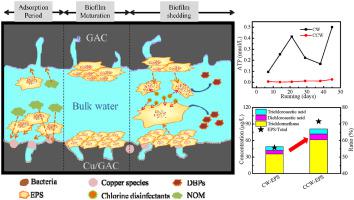Chemosphere ( IF 8.8 ) Pub Date : 2021-07-27 , DOI: 10.1016/j.chemosphere.2021.131686 Zhihao Bi 1 , Tong Li 1 , Xueci Xing 1 , Peng Qi 1 , Zesong Li 1 , Chun Hu 1 , Xiaoran Xu 2 , Zhimin Sun 2 , Gang Xu 3 , Chaoxiang Chen 3 , Kunyu Ma 3

|
Change in water quality was investigated with laboratory-scale ozone-biological activated carbon filters using copper-modified granular activated carbon (Cu/GAC) and unmodified granular activated carbon (GAC). In the first seven days of the experimental period, Cu/GAC removed organic matter more efficiently owing to its enhanced adsorption capacity. As the running time increased, the amount of disinfection by-products (DBPs), dissolved organic carbon, and extracellular polymeric substances (EPS) increased sharply in the effluent of the Cu/GAC filter (CCW). More importantly, the EPS suspended in the CCW exhibited weaker flocculating efficiency and hydrophobicity, causing more active chemical reactions between chlorine and EPS substances. The copper species significantly limited the microbial biomass (0.01 nmol/L adenosine triphosphate) but stimulated the secretion of significant amounts of EPS by microorganisms for self-protection. Furthermore, the microbial community in the bulk water was successfully shaped by Cu/GAC, resulting in a continuous supply of EPS-derived DBP precursors and a sharp rise in chlorine consumption in the downstream drinking water distribution. Therefore, use of modified GAC materials, similar to Cu/GAC, as carrier materials for biological activated carbon (BAC) treatment remains controversial, despite enhanced pollutant adsorption capacity. This is the first study to reveal the mechanism of BAC-modified materials for water quality stability. The study potentially contributes to a comprehensive understanding of the effects of biofilm transformation and microbial community succession on drinking water quality. These results showed that tap water safety risks could be reduced by improving BAC pretreatment in drinking water treatment plants.
中文翻译:

细胞外聚合物和微生物群落对饮用水质量安全的贡献:通过铜/活性炭生物过滤
使用铜改性颗粒活性炭 (Cu/GAC) 和未改性颗粒活性炭 (GAC) 的实验室规模臭氧生物活性炭过滤器研究了水质的变化。在实验的前 7 天,Cu/GAC 由于其增强的吸附能力而更有效地去除有机物。随着运行时间的增加,Cu/GAC 过滤器 (CCW) 流出物中的消毒副产物 (DBP)、溶解的有机碳和细胞外聚合物 (EPS) 的数量急剧增加。更重要的是,悬浮在 CCW 中的 EPS 表现出较弱的絮凝效率和疏水性,导致氯和 EPS 物质之间更活跃的化学反应。铜物种显着限制了微生物生物量(0. 01 nmol/L 三磷酸腺苷),但刺激微生物分泌大量 EPS 以进行自我保护。此外,大量水中的微生物群落被 Cu/GAC 成功塑造,导致 EPS 衍生的 DBP 前体的持续供应和下游饮用水分配中氯消耗量的急剧增加。因此,尽管增强了污染物吸附能力,但使用类似于 Cu/GAC 的改性 GAC 材料作为生物活性炭 (BAC) 处理的载体材料仍然存在争议。这是首次揭示 BAC 改性材料对水质稳定性的作用机制。该研究可能有助于全面了解生物膜转化和微生物群落演替对饮用水质量的影响。



























 京公网安备 11010802027423号
京公网安备 11010802027423号